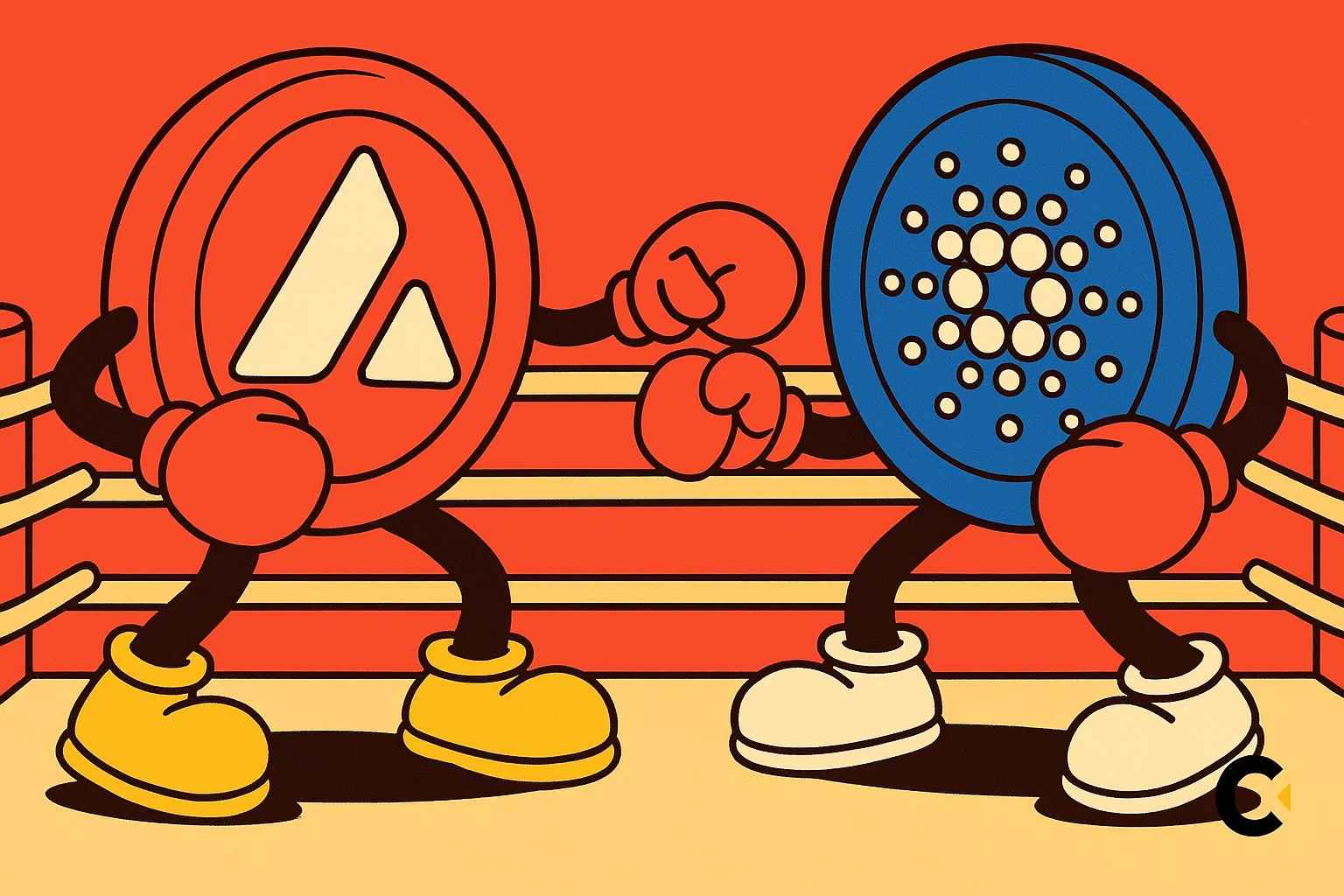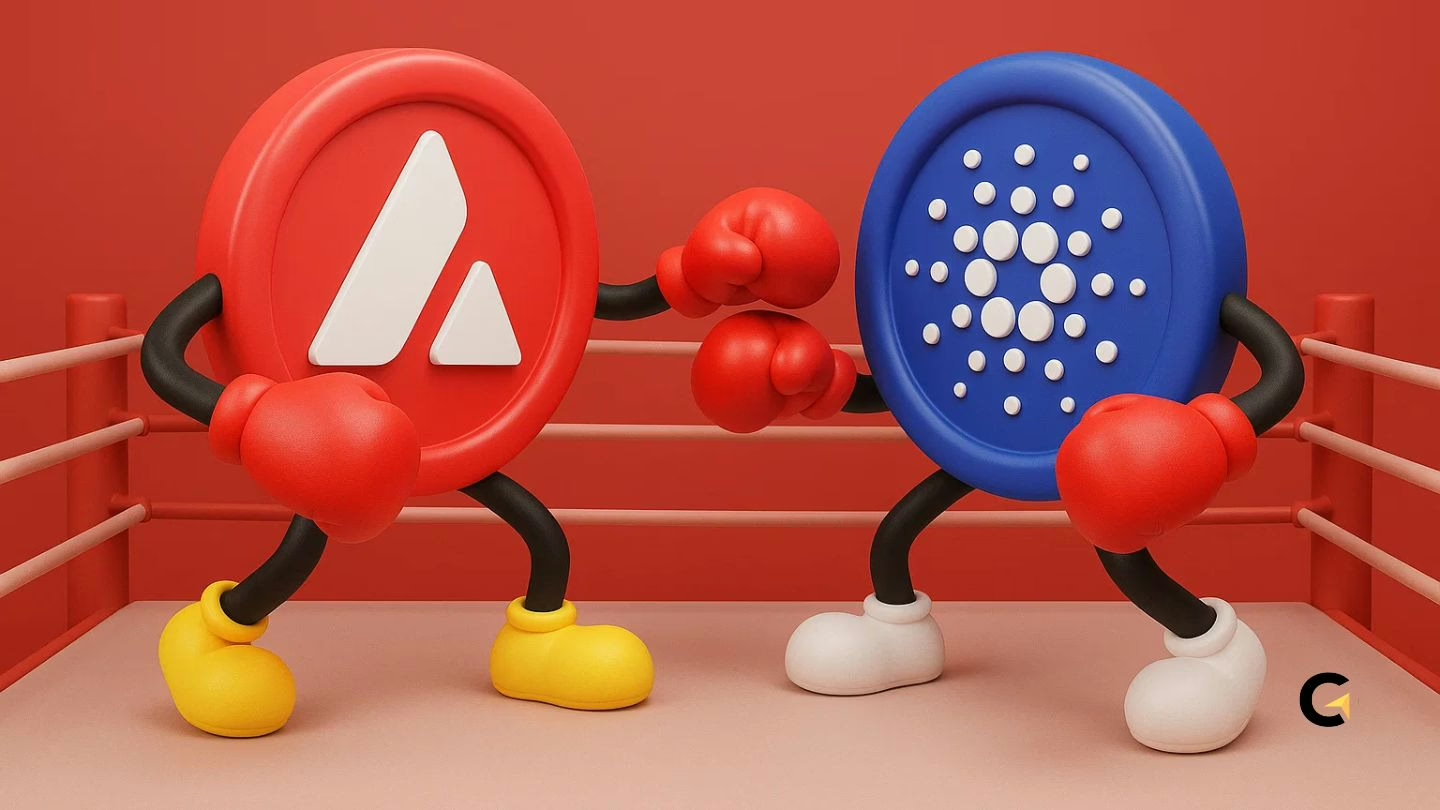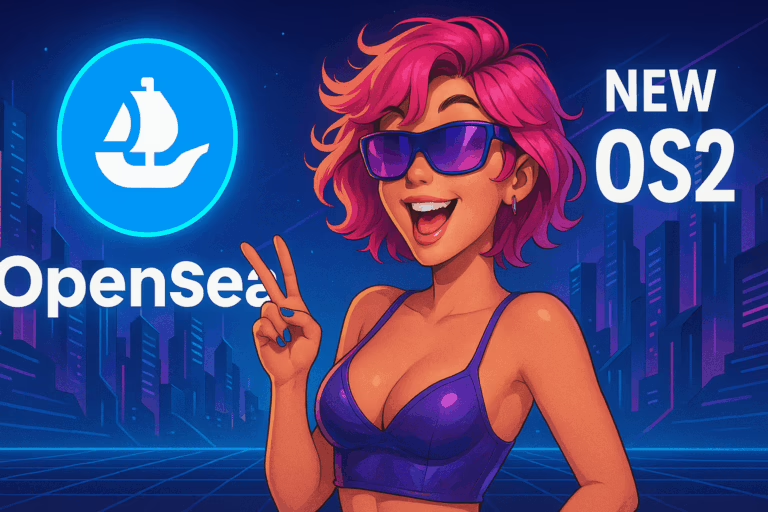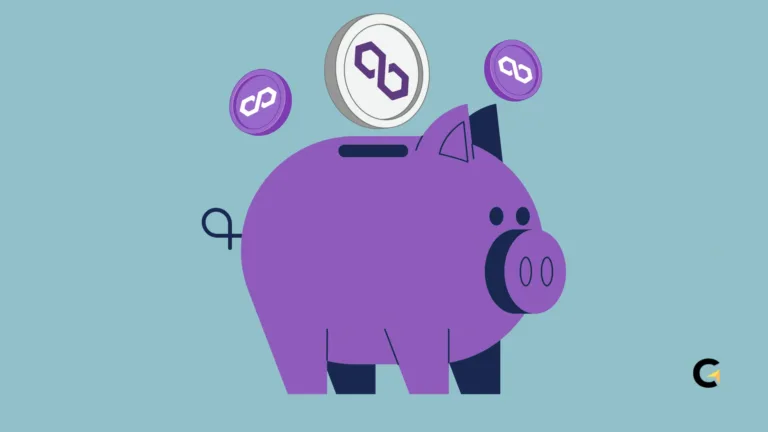Is AVAX better than Cardano?
Is AVAX better than Cardano? In short, Cardano (ADA) delivers low fees, deep liquidity, and peer-reviewed upgrades, but evolves slowly. Avalanche (AVAX) prioritizes fast execution, capped supply, and customizable Subnets, offering higher staking yields but thinner market depth. AVAX moves fast; ADA moves cautiously.
Key Takeaways:
Hide- Market Depth: Cardano has ~3× deeper liquidity than AVAX, though both maintain strong volume-to-cap ratios.
- Supply & Inflation: AVAX is hard-capped with emissions tapering to 0% by 2030; ADA has a fixed 45B cap with ~3% annual inflation.
- Speed vs. Decentralization: Avalanche finalizes in <2s with ~1,200 validators; Cardano takes ~10–20s with nearly 3,000 stake pools.
- Network Load: AVAX handles over 3.8M tx/day; Cardano averages ~71.5k tx/day despite its improved TPS ceiling.
- Staking Returns: AVAX yields ~7% annually; Cardano offers 3–4%, with no lock-up or minimum to delegate.
- Governance Models: AVAX uses on-chain validator votes; ADA is transitioning to Voltaire’s DRep system for formal on-chain governance.
- Development Styles: Avalanche prioritizes modular rollouts; Cardano follows peer-reviewed, upgrade-driven development.
- Regulatory Outlook: AVAX has ETF filings in progress; ADA still faces SEC classification concerns from 2023.
- Token Concentration: AVAX top 10 wallets hold ~2% of supply; Cardano’s top 10 hold ~10%, indicating broader ADA distribution.
- Use Case Focus: AVAX excels in gaming and subnet innovation; ADA emphasizes DeFi, privacy, identity, and long-term governance.
Choosing Between AVAX and Cardano: What Should Investors Know?

What matters more to your portfolio: Avalanche (AVAX) lightning-fast execution, hard-capped supply, and high staking yields—or Cardano (ADA) rigorously peer-reviewed upgrades, ultra-low fees, and deeper liquidity? Which trade-offs are you willing to make for speed and modularity versus academic-grade security and predictable economics?
1. Market Metrics
| AVAX | ADA | |
|---|---|---|
| Spot price | $17.96 | $0.575 |
| Market-cap | $7.58 B | $20.35 B |
| 24 h volume | $262 M | $706 M |
| Vol/Cap (liquidity) | 3.4 % | 3.5 % |
Insight: ADA trades on order-books roughly 3× deeper than AVAX’s, yet both assets maintain healthy liquidity ratios, suggesting efficient float handling.
2. Supply Dynamics
- Avalanche – Hard-cap of 720M AVAX; 422M (59%) in circulation. Annual inflation is ~7.4%, decreasing linearly to zero by 2030. All base-layer fees are burned.
- Cardano – Fixed cap of 45B ADA; 35.4B (79%) in circulation. Reserve-based emissions lead to ~3% inflation in 2025.
Take-away: AVAX enforces a hard cap on total supply, while ADA’s gradual 3% inflation runway could support a return to the $3–$5 range—analysts assess the catalysts required for a $50 breakout.
3. Consensus Mechanism & Security
| Avalanche | Cardano | |
|---|---|---|
| Algorithm | Snowman PoS (sub-sampled voting) | Ouroboros PoS (verifiably-random leader election) |
| Validators / Pools | ~1,220 validators | ~2,992 stake-pools |
| Typical finality | < 2 seconds | ~10–20 seconds |
| Exploits / outages | One 5-hour halt in Feb 2024; no re-orgs | No L1 halts; formalized code audit registry in place |
Security style: Avalanche achieves speed with fewer, high-bond validators; Cardano chooses wider distribution with lower cost per validator, increasing decentralization.
4. Network Activity
- Throughput capacity: Avalanche C-Chain benchmarked at ~4,500 TPS; Cardano upgraded to ~250 TPS post-Input Endorsers.
- Observed load (Q1 2025):
- AVAX: Averaged 3.8 M tx/day and 167k DAAs, spiking past 1M on major gaming launches.
- ADA: Processed 71.5k tx/day, with ~50k DAAs.
- Fee model:
- Avalanche: Dynamic base fee (cut ~96% in Avalanche 9000); fully burned.
- Cardano: Fixed formula fee (~$0.10/tx); routed to treasury, not burned.
5. Development & Ecosystem
| Metric | Avalanche | Cardano |
|---|---|---|
| Core repo stars | ~2.2k (avalanchego) |
~3k (cardano-node) |
| Contributors | ~165 | 300+ |
| Major upgrades | Teleporter (May 2025) for subnet messaging | Mithril, Input Endorsers, and the Chang governance upgrade |
| dApp niches | Gaming (e.g., MapleStory N), RWAs | DeFi, credentials, identity, privacy via Midnight sidechain |
Comparison: Avalanche pushes rapid L1 modularity; Cardano focuses on deliberate, peer-reviewed development and governance transitions.
6. Tokenomics & Utility
| AVAX | ADA | |
|---|---|---|
| Primary roles | Gas, subnet bond, staking, governance voting | Smart contract gas, staking, Voltaire governance (DReps) |
| Staking yield | ~7% (validators and delegators) | ~3–4% depending on pool returns |
| Lock-up period | 2 weeks – 1 year (2,000 AVAX minimum to validate) | No minimum to delegate; 15-day epochs |
| Monetary sinks | 100% of base fees burned + validator burn levy (May 2025) | Treasury accrues fees (340 ADA pool tax + 0.17 ADA/tx) |
7. Team, Community & Governance
- Founders:
- AVAX – Emin Gün Sirer (Cornell professor) & Ava Labs
- ADA – Charles Hoskinson, co-founder of Ethereum, leads IOHK (now IntersectMBO)
- Social presence:
- Cardano’s official account: ~1.35M followers
- Avalanche’s official account: ~700k followers
- Governance model:
- AVAX: On-chain parameter changes via ≥60% stake validator vote
- ADA: Transitioning to on-chain Voltaire voting via delegated representatives; current parameters require SPO agreement
8. Regulatory & Compliance
- Avalanche: Spot-ETF filings by Grayscale and Nasdaq in early 2025—still under SEC review.
- Cardano: ADA was listed in SEC enforcement complaints (2023); legal challenges ongoing, but the ecosystem refutes its classification as a security.
- Compliance tools:
- Avalanche supports KYC subnets (“Evergreen”)
- Cardano explores regulated side-chains (e.g., Midnight) but depends on off-chain compliance partners
9. Ecosystem Risk Factors
| Factor | Avalanche | Cardano |
|---|---|---|
| Audit & review | Bridge and wallets re-audited in 2024 | Formal registry via CIP-52; audits recommended for dApps |
| Bridge/oracle dependencies | Intel-SGX bridge enclave with eight wardens | Minimal reliance on bridges; depends on SPO-based oracles |
| Holder concentration (Top-10) | ~2% of supply | ~10% of supply |
Note: Avalanche concentrates systemic risk around its bridge architecture. Cardano spreads consensus but centralization may arise in treasury decision-making and custodial holdings.
10. Macro & Sentiment Indicators
- Market mood:
- ADA – Galaxy Score in high 60s (mild bullish)
- AVAX – Galaxy Score in low 60s (neutral); both trail SOL and DOGE as of June 2025
- BTC correlation:
- ADA increasingly “decoupled” since Q2 2025
- AVAX still highly reactive to alt-coin cycles
- On-chain revenues:
- AVAX: Fee burn dropped 62% QoQ due to fee cuts despite gaming activity
- ADA: Treasury income rising steadily, reflecting growing transaction base
Where Does AVAX Excel Over Cardano?
Overall, Avalanche leads in transaction speed, modular flexibility, and staking APY. Cardano prioritizes academic integrity, broader validator distribution, and low, transparent fees.
While, AVAX aligns with “sound money” through its hard cap and full fee burn. ADA favors long-tail emissions with reserve decay, promoting treasury sustainability.
Then, AVAX awaits ETF decisions but currently has regulatory breathing room. While, ADA battles ongoing scrutiny, creating uncertainty despite strong community advocacy.
Choose AVAX if you seek cutting-edge speed, modular blockchain design, and maximum fee-burn economics. Then, choose ADA if you value scientific rigor, staking accessibility, and a proven reputation in compliant, slow-burn innovation.







